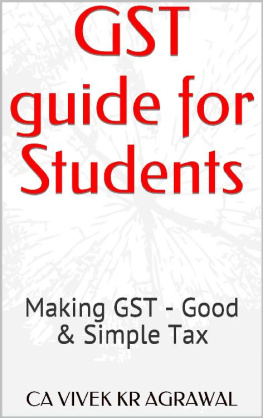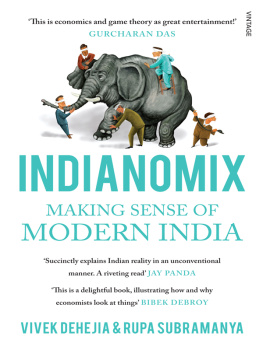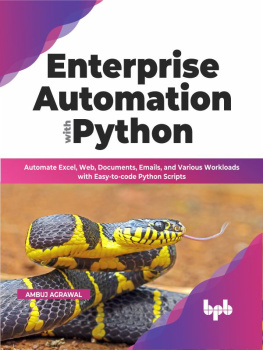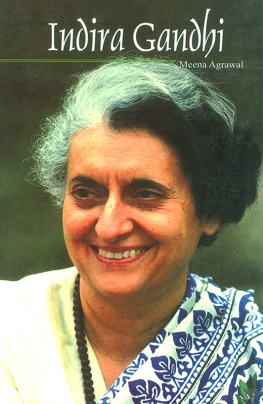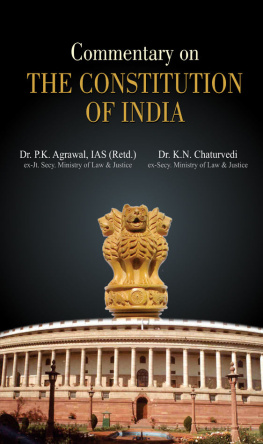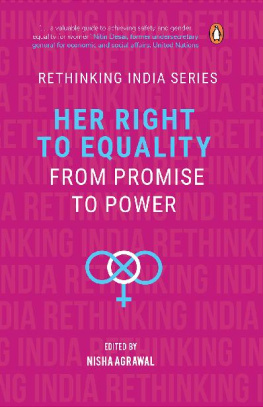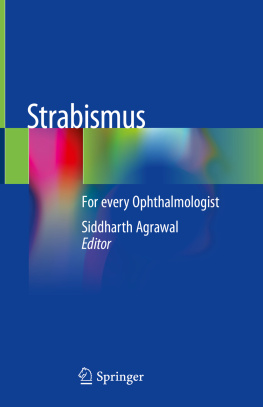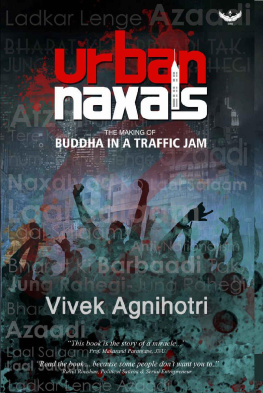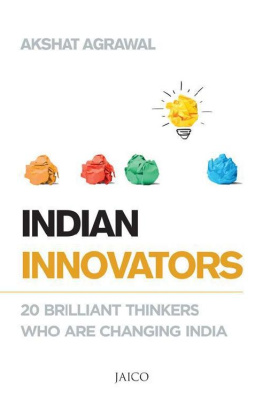Ca Vivek Kr Agrawal - GST guide for Students: Making GST - Good & Simple Tax
Here you can read online Ca Vivek Kr Agrawal - GST guide for Students: Making GST - Good & Simple Tax full text of the book (entire story) in english for free. Download pdf and epub, get meaning, cover and reviews about this ebook. year: 2017, genre: Politics. Description of the work, (preface) as well as reviews are available. Best literature library LitArk.com created for fans of good reading and offers a wide selection of genres:
Romance novel
Science fiction
Adventure
Detective
Science
History
Home and family
Prose
Art
Politics
Computer
Non-fiction
Religion
Business
Children
Humor
Choose a favorite category and find really read worthwhile books. Enjoy immersion in the world of imagination, feel the emotions of the characters or learn something new for yourself, make an fascinating discovery.
- Book:GST guide for Students: Making GST - Good & Simple Tax
- Author:
- Genre:
- Year:2017
- Rating:3 / 5
- Favourites:Add to favourites
- Your mark:
- 60
- 1
- 2
- 3
- 4
- 5
GST guide for Students: Making GST - Good & Simple Tax: summary, description and annotation
We offer to read an annotation, description, summary or preface (depends on what the author of the book "GST guide for Students: Making GST - Good & Simple Tax" wrote himself). If you haven't found the necessary information about the book — write in the comments, we will try to find it.
GST guide for Students: Making GST - Good & Simple Tax — read online for free the complete book (whole text) full work
Below is the text of the book, divided by pages. System saving the place of the last page read, allows you to conveniently read the book "GST guide for Students: Making GST - Good & Simple Tax" online for free, without having to search again every time where you left off. Put a bookmark, and you can go to the page where you finished reading at any time.
Font size:
Interval:
Bookmark:
CONTENTS OF THE BOOK:
TOPIC | PAGE NO |
INTRODUCTION | |
REGISTRATIONS | |
TIME OF SUPPLY | |
VALUE OF SUPPLY | |
PLACE OF SUPPLY | |
INPUT TAX CREDIT | |
PAYMENT OF TAX | |
COMPOSITION SCHEME | |
INVOICING | |
ACCOUNTS AND RECORDS | |
REVERSE CHARGE | |
TDS & TCS | |
GST RETURNS | |
JOB WORK | |
REFUNDS | |
PENALTY | |
ASSESSMENTS | |
APPEALS | |
DEMAND AND RECOVERY | |
INSPECTION, SEARCH, SEIZURE AND ARREST | |
IMPORTANT DEFINITIONS |
ABOUT THE AUTHOR:
VIVEK KR AGRAWAL, is a member of The Institute of Chartered Accountants of India. He is fellow member of the Institute. He has the experience of more than 10 years in the field of Tax Consultancy. He has also qualified L.L.B., Diploma in Insurance & Risk Management and Diploma in Information System Audit. Associated in different capacities with several Professional Institutes, Management colleges and Business houses in India and abroad. He can be reached at vivek.vka@gmail.com.
INTRODUCTION
The Goods and Services Tax (GST) the biggest reform in Indirect taxation of India has been rolled out from 01 st July, 2017. It extends to whole of India. It is based on the principle of destination-based consumption taxation.
By the Constitution amendments passed in parliament and ratified by various state, now the Central and State governments will have simultaneous powers to levy the GST on Intra-State supply. Though the Parliament alone shall have exclusive power to make laws with respect to levy of Goods and Services Tax on Inter-State supply. GST to be levied by the Centre would be called Central GST (CGST) and that to be levied by the States would be called State GST (SGST). An Integrated GST (IGST) would be levied an inter-state supply of goods or services.
As the government wants to have unified tax structure across the country the cooperation is required from every state on various matter, so The Goods and Service Tax Council (GSTC) was formed. GSTC comprises of the Union Finance Minister, the Minister of State (Revenue) and the State Finance Ministers to recommend on the GST rate, exemption and thresholds, taxes to be subsumed and other matters.
The whole GST system will be backed by a robust IT system. In this regard, Goods and Services Tax Network (GSTN) has been set up by the Government. It will provide front end services and will also develop back end IT modules for States who opted for the same.
Major taxes subsumed in GST are:
- Central Excise Duty
- Duties of Excise (Medicinal and Toilet Preparations)
- Additional Duties of Customs (CVD)
- Special Additional Duty of Customs(SAD)
- Service Tax
- State Value Added Tax (VAT)
- Central Sales Tax (CST)
- Entry Tax
- Purchase Tax
- Luxury Tax
- Taxes on lotteries, betting and gambling
GST would apply on all goods and services except Alcohol for human consumption. GST on five specified petroleum products (Crude, Petrol, Diesel, ATF & Natural Gas) would by applicable from a date to be recommended by the GST Council.
Below a simple example to explain the significance of various terms and topics to be covered going forward.
Example Rahul from Mumbai has purchased laptop from Flipkart, Bengaluru for Rs 40,000. The market price of product is Rs 50000/-. The tax rate is 18%.
Question: Is this transaction liable to GST?
Answer: To know this we need to understand the basic structure of gst, meaning of supply and related concepts.
Question: Who needs to pay GST?
Answer: Basic concept and Reverse charge mechanism.
Question: On what value of amount, tax rate will apply?
Answer: Value of Supply topic.
Question: Whether CGST-SGST or IGST needs to be charged?
Answer: Place of Supply topic.
Question: When is liability to pay tax to the tax department arise?
Answer: Time of Supply topic.
Question: How to pay the tax?
Answer: Input Tax Credit and Payment of tax topic.
Question: What proof should be kept of the transaction for future purpose?
Answer: Invoicing, Accounts and Records topic.
Question: What related compliances needs to be done?
Answer: GST returns topic.
Another simple example to elucidate the working of GST.
Example : Rajesh sold the goods to Mahesh for Rs 10,000. GST rate is 18%. Both are located in Karnataka.
Answer:
Value of goods Rs 10,000
CGST Rs 900
SGST Rs 900
Gross Value Rs 11,800
Example : Ranbir, Mumbai sold the goods to Rajni, Chennai for Rs 10,000. GST rate is 18%.
Answer:
Value of goods Rs 10,000
IGST Rs 1800
Gross Value Rs 11,800
CONCEPT OF SUPPLY
A taxable event is any event or occurrence that results in a tax liability . The taxable event in GST is supply of goods or services or both. So the first and the foremost condition to make transaction taxable to GST is Supply.
Various taxable events like manufacture(for excise), sale(for VAT), rendering of service(for Service tax), purchase(for purchase tax), entry into a territory of state(for Entry tax) and many other have been done away with in favour of just one event i.e. Supply.
In general words, Supply means To Provide. It includes sale, transfer, barter, exchange, license, rental, lease or disposal.
Next we discuss few universal condition to be fulfilled by a transaction to make it chargeable to GST. This can be better understood in terms of following six parameters:
1. Supply of goods or services . Supply of anything other than goods or services does not attract GST. So it is important to know what is Goods and what is Services (Covered under Definition Chapter)
2. Supply should be made for a consideration ( a payment or reward ) . It is immaterial whether the payment is made by the recipient or by any other person.
Example Tata Motors sold a car to Abhishek Bachchan, the car was registered under his name. The payment for the car was however made by Amitabh Bachchan. Is the selling of the car to Abhishek Bachchan considered as Supply? Answer is YES.
3. Supply should be made in the course or furtherance of business . That is personal dealing wont be regarded as supply.
Example - A Dealer of Cement buys cement for trading, is considered as Supply.
Example The same dealer if buys laptop to keep accounting of the stock, this buying of laptop of his business will also be regarded as Supply, as it will be used in the furtherance of his business.
Example A homemaker lady selling of old newspaper or plastic waste to raddiwala wont be considered as supply. As the lady is just selling the unusable material on her house which is primarily not for business purpose.
Example A lady went to Jewellery shop to sell her old jewels. As she is not a regular dealer selling jewellery, this wont be considered as supply under GST.
4. Supply should be made by a taxable person .
A taxable person is a person who is registered or liable to be registered under the GST law. Hence, even an unregistered person who is liable to be registered is a taxable person. Similarly, a person not liable to be registered but has taken voluntary registration and got himself registered is also a taxable person.
Next pageFont size:
Interval:
Bookmark:
Similar books «GST guide for Students: Making GST - Good & Simple Tax»
Look at similar books to GST guide for Students: Making GST - Good & Simple Tax. We have selected literature similar in name and meaning in the hope of providing readers with more options to find new, interesting, not yet read works.
Discussion, reviews of the book GST guide for Students: Making GST - Good & Simple Tax and just readers' own opinions. Leave your comments, write what you think about the work, its meaning or the main characters. Specify what exactly you liked and what you didn't like, and why you think so.

